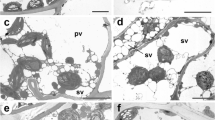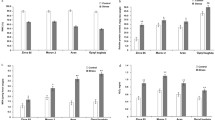Abstract
The resurrection species Sporobolus stapfianus Gandoger has been studied by LM, TEM and SEM in order to define the leaf morphology and fine structure and to analyse the cellular changes occurring during the processes of dehydration and rehydration of the plant. Some characteristics of the fully hydrated leaf and some ultrastructural and physiological events which take place during leaf wilting are discussed in relation to their possible role in plant desiccation-tolerance.
The leaves of S. stapfianus show several characteristics common among xerophytic species. In the resurrection leaf they could play a role in slowing down the drying rate, thus leaving time to activate the mechanisms protecting the cell structures against drought damage. Actually, the S. stapfianus leaves do not undergo important cellular alterations during dehydration. The chloroplasts, in particular, retain part of their photosynthetic pigments and thylakoid membranes. Upon rewatering leaf recovery is rather fast and the tissue structure and cell organization of the fully hydrated state are already regained after two days.
Similar content being viewed by others
References
Bartley Mand Hallam ND (1979) Changes in the fine structure of the desiccation-tolerant sedge Coleochloa setifera (Ridley) Gilly under water stress. Austr. J. Bot. 27: 531-545
Bartels D, Schneider K, Terstappen G, Piatkowski D and Salamini F (1990) Molecular cloning of abscisic acid-modulated genes which are induced during desiccation of the resurrection plant Craterostigma plantagineum. Planta 181: 27-34
Bewley JD (1979) Physiological aspects of desiccation-tolerance. Annu. Rev. Plant Physiol. 30: 195-238
Bewley JD and Oliver MJ (1992) Desiccation-tolerance in vegetative plant tissues and seeds: Protein synthesis in relation to desiccation and a potential role for protection and repair mechanisms. In: Osmond CB Somero G and Bolis CL (eds) Water and Life: A Comparative Analysis of Water Relationship at the Organismic, Cellular and Molecular Levels, pp 141-160. Berlin: Springer Verlag
Bianchi G, Gamba A, Murelli C, Salamini F and Bartels D (1992) Low molecular weight solutes in desiccated and ABA treated calli and leaves of Craterostigma plantagineum. Phytochemistry 31: 1917-1922
Drennan PM, Smith MT, Goldsworthy D and van Staden J (1993) The occurrence of trehalose in the leaves of the desiccation-tolerant angiosperm Myrothamnus flabellifolius Welw. J. Plant Physiol. 142: 493-496
Durand JL, Onillon B, Schnyder H and Rademacher I (1995) Drought effects on cellular and spatial parameters of leaf growth in tall fescue. J. Exp. Bot. 46: 1147-1155
Hallam ND and Luff SE (1980) Fine structural changes in the leaves of the desiccation-tolerant plant Talbotia elegans during extreme water stress. Bot. Gaz. 141: 180-187
Heterington SE, Hallam ND and Smillie RM (1982) Ultrastructural and compositional changes in chloroplast thylakoids of leaves of Borya nitida during humidity-sensitive degreening. Austr. J. Plant Physiol. 9: 601-609
Kaiser K (1985) Sugar contents of leaves of desiccationsensitive and desiccation-tolerant plants. Naturwiss. 72: 608- 609
Kuang J, Gaff DF, Gianello RD, Blomstedt CK, Neale AD and Hamill JD (1995) Changes in in vivo protein complements in drying leaves of the desiccation-tolerant grass Sporobolus stapfianus and the desiccation-sensitive grass Sporobolus pyramidalis. Aust. J. Plant Physiol. 22: 1027-1034
Marinone Albini F, Murelli C, Patritti G, Rovati M, Zienna P and Finzi PV (1994) Low-molecular weight substances from the resurrection plant Sporobolus stapfianus. Phytochemistry 37: 137-142
Markoska YK, Tsonev TD, Kimenov GP and Tutekova AA (1994) Physiological changes in higher poikilohydric plants Haberlea rhodopensis Friv. and Ramonda serbica Panc. during drought and rewatering at different light regimes. J. Plant Physiol. 144: 100-108
Mendez MP, Jimenez MS, Morales D, Perin V and Rascio N (1994) Anatomical and ultrastructural leaf characteristics of some plants from the Canary Islands. Cytobios 77: 87-100
Metcalfe RC (1960) Anatomy of the Monocotyledons. I. Gramineae. New York: Clarendon Press
Meyer BS and Anderson DB (1952) Plant Physiology. 2nd ed. New York: D. Van Nostrand Company, Inc.
Oliver MJ (1996) Desiccation tolerance in vegetative plant cells. Physiol. Plant. 97: 779-787
Porra RJ, Thompson WA, Kriedermann PE (1989) Determination of accurate extinction coefficients and simultaneous equations for assaying chlorophylls a and b extracted with four different solvents: Verification of the concentration of chlorophyll standards by atomic spectroscopy. Biochim. Biophys. Acta 975: 384-394
Prendergast HDV and Hattersley PW (1987) Australian C4 grasses (Poaceae): Leaf blade anatomical features in relation to C4 acid decarboxylation types. Austr. J. Bot. 35: 355- 382
Schonbeck MW and Bewley JD (1981) Responses of the moss Tortula ruralis to the desiccation treatements. I. Effects ofminimum water content and rates of dehydration and rehydration. Can. J. Bot. 59: 2698-2706
Schwab KB and Gaff DF (1986) Influence of compatible solutes on soluble enzymes from desiccation-tolerant Sporobolus stapfianus and desiccation sensitive Sporobolus pyramidalis. J. Plant Physiol. 137: 208-215
Schwab KB and Heber U(1984) Thylakoid membrane stability in drought-tolerant and drought-sensitive plants. Planta 161: 37-45
Schwab KB, Schreiber U and Heber U (1989) Response of photosynthesis and respiration of resurrection plants to desiccation and rehydration. Planta 177: 217-227
Sgherri CLM, Loggini B, Puliga S and Navari-Izzo F (1994) Antioxidant system in Sporobolus stapfianus: Changes in response to desiccation and rehydration. Phytochemistry 35: 561-565
Sherwin HW and Farrant JM (1996) Differences in rehydration of three desiccation-tolerant angiosperm species. Ann. Bot. 78: 703-710
Suau R, Cuevas A, Valpuesta V and Reid MS (1991) Arbutin and sucrose in the leaves of the resurrection plant Myrothamnus flabellifolia. Phytochemistry 30: 2555-2556
Taiz L and Zeiger E (1991) Plant Physiology. Redwood City, California: The Benjamin/Cummings Publishing. Comp., Inc.
Tuba Z, Lichtenthaler HK, Maroti I and Csintalan Z (1993) Resynthesis of thylakoids and functional chloroplasts in the desiccated leaves of the poikilochlorophyllous plant Xerophyta scabrida upon rehydration. J. Plant Physiol. 142: 742-748
Wellburn FAM and Wellburn AR (1976) Novel chloroplasts and unusual cellular ultrastructure in the “resurrection plant” Myrothamnus flabellifolia Welw. (Myrothamnaceae). Bot. J. Linnean Soc. 72: 51-54
Author information
Authors and Affiliations
Rights and permissions
About this article
Cite this article
Vecchia, F.D., El Asmar, T., Calamassi, R. et al. Morphological and ultrastructural aspects of dehydration and rehydration in leaves of Sporobolus stapfianus. Plant Growth Regulation 24, 219–228 (1998). https://doi.org/10.1023/A:1005853527769
Issue Date:
DOI: https://doi.org/10.1023/A:1005853527769




